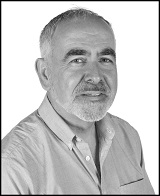 Exams and the pre Christmas rush notwithstanding, a triple-line party whip was in force within the family for the midnight first screening of Star Wars, The Force Awakens. Sitting in the back row of a packed, expectant, and goodnatured cinema, I was struck by the number of contemporaries also attending with adult and teen children.
Exams and the pre Christmas rush notwithstanding, a triple-line party whip was in force within the family for the midnight first screening of Star Wars, The Force Awakens. Sitting in the back row of a packed, expectant, and goodnatured cinema, I was struck by the number of contemporaries also attending with adult and teen children.
They, like me, almost certainly had vivid memories of the “real” first Star Wars movie of 38 years ago, screened when I was a student in first med. A histology practical took a severe hit as a goodly proportion of the class went to a matinée showing of the movie, and light sabre battles with bicycle lamps in the darkened locker room were the order of the day for weeks thereafter.
Earlier that evening I had been at an almost equally full house for one of our Medical Humanities seminars, a droll and learned overview on vampires in the European tradition with a response from a haematologist.
The impact of both events set me thinking about Bruno Bettelheim’s classic analysis of fairy tales, The Uses of Enchantment. In German the title is Kinder Brauchen Märchen—Children Need Fairy Tales—and perhaps we need to recognize more openly that adults also need fairy tales, not only as entertainment but also to tease out dark and uncertain elements of human existence.
Indeed, the early history of vampirism, as one author astutely noted, shows that ghosts and encounters with the undead are not superstitious relics of a pre-modern past, or the Enlightenment’s other, but intimate companions of Western modernity.
Of equal interest both as gerontologist and an individual, was the impact of ageing on the stars of the original Star Wars. The lithe and lissome Princess Leia was of a similar age to our group of medical students when Carrie Fisher played the role in 1977, and Harrison Ford a relatively youthful 35 year-old.
Older actors are undergoing a remarkable exposure in the movie industry currently, with a notable concentration of older actors nominated for a range of awards, typified by Michael Caine, Harvey Keitel and Jane Fonda (with an average of 78) in Youth (due for release in the UK at the end of January 2016).
The difference in Star Wars is the reprise of roles 38 years later, casting an interesting light on not only their ageing but also a reflection on our own, comparing and contrasting the experiences, losses and gains of the intervening years.
From the perspective of comparative biology, it appears that Wookies have a different ageing trajectory to humans: Chewbacca looked in remarkably good shape, limber in limb and no evidence of incipient alopecia. The lustrous shine and colour of his hair (assuming that regular dyeing would be too major a task to contemplate in his case) suggest a resistance to the oxidative stress that underlies our own grey tresses.
The increasingly grizzled and grey Harrison Ford ages gracefully, relying on cunning and subterfuge rather than acrobatics to avoid tight corners, reminiscent of PJ O’Rourke’s Age and Guile Beat Youth, Innocence and a Bad Haircut.
The change was greatest for Carrie Fisher, particularly in a movie industry where female stardom is still obsessed with body image and youthfulness. To portray Princess Leia in a positively matronly fashion was very brave, and reflected a victory over her struggles in real life with mental health, alcohol and drugs as outlined in her memoir, Wishful Drinking.
In some ways this served as an anchor of reality through a fourth wall in the movie, and perhaps allowed a linkage to the trials and tribulations of life of us ordinary people in the fifties watching the movie who may equally not have retained our matinée idol looks.
And the movie? Smart and fun, with the Oedipal themes running through the movies reflected in how JJ Abrams, an 11 year old at the time of the first Star Wars, has rendered homage—but also constructively disrupted—the inheritance and vision of George Lucas.
The final few minutes, filmed on the magnificent Skellig Islands off the west coast of Ireland, are breath-taking. That early Christians founded a monastic settlement in such a bleak and magnificent setting reminds us of the limitations of the intellect alone in man’s search for wider meaning, and resonates with a cinematic experience rooted in fable and myth.
Des O’Neill is a geriatrician and cultural gerontologist in Dublin, and co-chair of the Medical and Health Humanities Initiative in Trinity College Dublin.